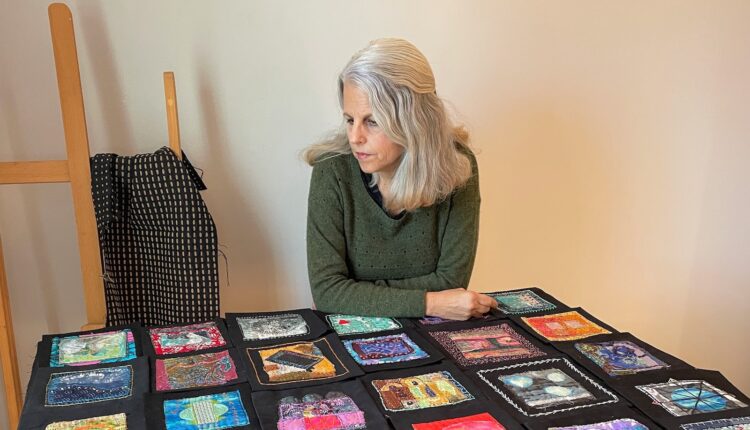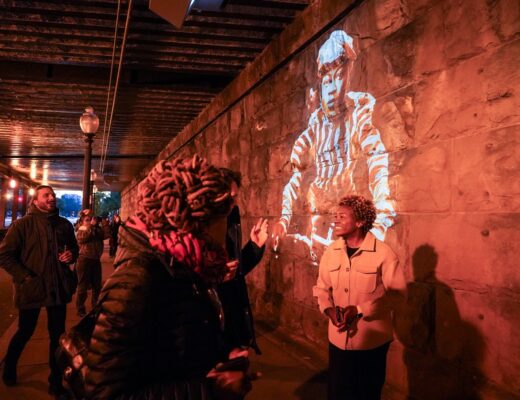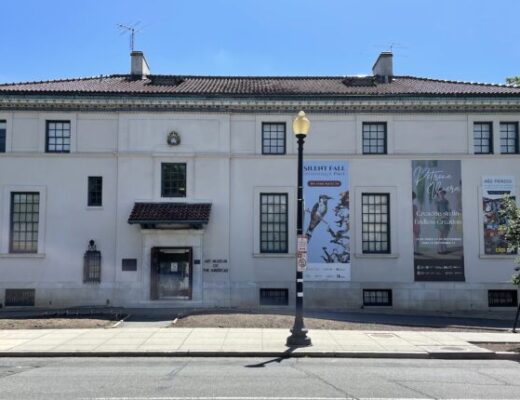by Dylan Klempner
This article was first published in The DC Line here.
As the COVID-19 pandemic continues to drive demand for mental health services, a DC-based group of art therapists is participating in an online exhibit that highlights the potential for cultivating resilience through art making.
According to the Kaiser Family Foundation, 35.9% of adults in the District reported symptoms of anxiety and/or depressive disorder in a survey conducted from Sept. 29 to Oct. 11, 2021. This figure is somewhat higher than the 31.6% of adults nationwide who reported these symptoms.
As the need for mental health support has grown, therapists themselves have also reported symptoms of burnout. Some concerned about increased demand on already-strained mental health professionals are labeling this “another pandemic mental health crisis” and are calling for changes in the nation’s mental health system, including added support for therapists.
Amid these trends, art therapists in the greater Washington, DC, area are using an online art exhibit to build community and share personal examples of art’s therapeutic potential.
Works by 25 art therapists are part of “Resilience Through Art in 2020 – 2021,” an online exhibit available on the website of the Potomac Art Therapy Association (PATA), a professional organization serving the Washington area. The group is a chapter of the national American Art Therapy Association (AATA) based in Alexandria, Virginia.
An untitled work by Tyler Strusowski, president of the Potomac Art Therapy Association’s board, is part of the exhibit of works by 25 art therapists. (Photo courtesy of Tyler Strusowski)
Tyler Strusowski, president of PATA’s board, is one of the art therapists whose work is in the show.
Prior to the pandemic, he had been working as an art therapist and artist-in-residence at the McClendon Center, which provides mental health services in DC and operates an art studio for its clients.
Tyler Strusowski
A month into the spring 2020 lockdowns, the DC-based art therapist remembers craving the art making he was missing. “When I was working at the McClendon Center, art was in my life, every day,” said Strusowski. “When we went into lockdown, it wasn’t.”
Inspired by the tulips and poppies blooming in his Northeast DC neighborhood, Strusowski bought a large canvas and began collecting collage materials.
While working on his piece at home, Strusowski learned that a client he had become close to had died. As he dealt with his feelings about her death, art making served a therapeutic role, he said. “I was mourning her through that process.”
Art therapy defined
Research has confirmed the effectiveness of art therapy, a mental health profession that specifically integrates psychotherapy theories and practices with the intentional selection of art materials, according to Jordan Potash, associate professor in the Art Therapy Program at George Washington University.
“With an art therapist, a substantial amount of time is going to be spent actually creating artwork,” said Potash.
Making art during an art therapy session can help clients relax, a welcome contrast to how they might respond in a different context, said Tally Tripp, associate professor and founding director of the George Washington University Art Therapy Clinic in Alexandria, Virginia.
“It doesn’t have quite the same stress involved in the purely verbal therapeutic relationship,” she said.
Tripp said that some clients, especially those who have dealt with trauma, may have difficulty accessing words and emotions. Art making offers tools she can use as their therapist.
“We can work with clay or experiment with different kinds of media, and that’s going to promote a healing that is really strengths based,” Tripp said.
Tracy Councill, program director and co-founder of the DC-based nonprofit Tracy’s Kids, created prayer flags for the exhibit. (Photo courtesy of Tracy Councill)
Art therapy can help people cultivate resilience because it is an “active and engaged practice” that provides a sense of control, said Tracy Councill, program director and co-founder of the DC-based nonprofit Tracy’s Kids.
“It puts you in a position of control. And that can be very meaningful to people in therapy,” she said.
Like other mental health professionals, art therapists must undergo academic and clinical training before obtaining credentials to practice, said Potash.
The Art Therapy Credentials Board, a group based in Greensboro, North Carolina, offers testing that leads to a national credential for art therapists. Practitioners may also need to pursue additional licensure in their home state. More than a dozen states, including Maryland and Delaware, have passed laws granting licensure specifically for art therapists, and DC recently followed suit.
“Licensure laws, in general, are there to protect the public,” said Potash, who serves as chair of PATA’s licensure committee. “Only somebody who has the unique education and qualifications of an art therapist will be able to call themselves an art therapist.”
The Professional Art Therapist Licensure Amendment Act was signed into law in DC by Mayor Muriel Bowser in April 2020. The law, passed by the DC Council at PATA’s behest, lists qualifications and standards to practice as a professional art therapist in the District.
Art therapy and resilience
Councill said many art therapists use their personal art practices to process their own experiences. “In my work, there is a lot of sadness and loss, right, because I work with a lot of kids with serious illnesses.”
Tracy Councill
Though she rarely makes art directly about losing a patient or someone close to her, Councill has a “need to be creatively engaged. I need to have an arena in which I feel that sense of agency and that ability to respond and be resilient.”
That’s the line of thinking that led Kelly Jacobs, PATA’s vice president of communications, to come up with the idea for the online art show.
She said that as the shutdowns took hold, she tried to think of creative ways in which members could connect and share their artistic experiences without requiring a Zoom call. Together, she and her colleagues settled on the idea for the show’s title, which focuses on the idea of resilience.
Jacobs said she heard from art therapists in the early days of the pandemic about the stress they were under, the challenges they faced, and the adaptations they made.
“It was hard, but there was so much creativity that was happening. And that all seemed to just kind of relate to this idea of resilience,” said Jacobs. “Adapting, being creative, growing from the experience.”
For the artwork she submitted to the PATA art show, Tripp used a technique known as slow stitching, which emphasizes the use of needle and thread for art making rather than for their more practical purposes, such as mending. Tripp said the practice is good for stress reduction. “It was just a way to be focused and relaxed.”
Tally Tripp submitted her stitching project for the online exhibit. (Photo by Mark Morrow)
A half-century of art therapy in DC
The history of art therapy locally goes back at least a half-century. In 1971, Bernard Levy and Elinor Ulman co-founded George Washington University’s Art Therapy Program, one of the nation’s first.
The DC area has also been home to leading art therapy programs including Creative Forces: NEA Military Healing Arts Network, a partnership of the National Endowment for the Arts and the Department of Defense that began in 2004.
Tracy’s Kids, a medical art therapy program for children dealing with cancer, had its start at Georgetown Lombardi Comprehensive Cancer Center. The nonprofit now also supports seven other art therapy clinics at pediatric cancer hospitals, including Children’s National Hospital.
Art therapy and the political sphere
Art therapy has long enjoyed bipartisan backing from politicians and their families.
Just a few months after the Sept. 11, 2001, terrorist attacks, Hillary Rodham Clinton – then a newly elected New York senator – read a Congressional Record statement supporting art therapy as a mental health field.
Marcelle Leahy, wife of Vermont Sen. Patrick Leahy, is a Tracy’s Kids board member, while Karen Pence, former Tracy’s Kids board member and former second lady, has played, perhaps, the most visible role in raising awareness about the field.
Shortly after the inauguration of President Donald Trump in 2017, Pence announced that art therapy would be her signature cause.
But many art therapists challenged the AATA’s willingness to embrace the second lady as an ally. In protest, more than 1,700 joined a Facebook group known as Art Therapists for Human Rights.
“We demand that AATA respond to Karen Pence’s stated commitment to our field by asking her to publicly take action for the rights of … all people who are in danger as a result of the policies of the current administration,” reads a statement on the group’s page describing its mission during the Trump administration.
Pence’s interest in art therapy prompted a lot of conversations among art therapists about government policies and other factors that impact their clients, Potash said.
“Systemic racism takes a toll on clients and limits their ability to access services in ways that they can’t overcome on their own,” said Potash. In the years since Pence’s endorsement, he added, AATA has reviewed its policies and practices and looked “at how to make changes in the interest of equity and inclusion.”
Art therapy and social justice
Potash uses art therapy to facilitate intergroup dialogue. Art therapists, he said, can play a meaningful role in supporting social justice and community development.
Art can help people visualize systemic injustices, said Potash. “But just showing them might not be enough.”
Art therapists, he explained, can help untrained audiences who may not have the skills to see meaning in a work of art — a role particularly valuable when it comes to getting a deeper understanding of artwork about injustices.
“Art therapists can help to lead meaningful opportunities for viewers to really get a sense of what it is the artists are trying to convey,” he said.
As a result of art therapists’ training in psychotherapy and group dynamics, they can also help people use art to communicate about their differences and come up with new policies and programs.
“Art therapists can also — using our skills in groups and whatnot — create art making opportunities where people come together to create art and to try to reimagine ways in which the world could be.”
Participants at a workshop held as part of George Washington University’s Martin Luther King Jr. Day of Service were asked to create images of a personal experience that defined their social. cultural or political outlook. (Photo courtesy of Jordan Potash and Alberta Gyimah-Boadi)
Prior to the pandemic, Potash and a colleague, art therapist Alberta Gyimah-Boadi, led a series of intergroup dialogue workshops that incorporated art making at GW during its Martin Luther King Jr. Day of Service, as well as at public libraries in the District and in Virginia, they said.
“We ask people to come and create art [based] on an experience from their life that has led them to their current political views,” said Potash. “The goal of this is to refocus people not so much on political debate, but that people’s perspectives come from somewhere.”
Gyimah-Boadi said she and Potash were inspired by King’s teachings that encourage people to work together to fix a flawed system. The two of them asked participants to use art making to focus on one another’s stories rather than on their individual views.
“People may see the issue differently,” said Gyimah-Boadi. “But at the bottom of it, there’s still an issue.”
For PATA’s virtual show, several art therapists submitted artwork focused on social justice.
Councill contributed three pieces titled “Prayer Flag Portraits” that depict the faces of George Floyd, Breonna Taylor and Ahmaud Arbery, whose deaths prompted massive Black Lives Matter protests around the world during the spring and summer of 2020.
Councill, who attended some of the protests, said that the prayer flags are a form of personal expression. “They’re still hanging on the front of my house.”
She also brought the art to work at the Georgetown Lombardi Comprehensive Cancer Center, the site of one of the Tracy’s Kids art therapy clinics. Many of the children being treated there are African American, she said.
“I wanted to make it very, very clear to the kids and families that I work with, that I want to do everything I could to be present to them,” Councill said.
“The kids also made their own prayer flags about things that they were worried about during that time,” she said. Some made art about the protests, violence and the pandemic.
For Strusowski, art making works therapeutically for him in multiple ways. “It becomes my way of processing things that happen and developing insights as to what my feelings actually are,” he said.
He described insights that arose during the spring of 2020 while he worked on his piece for the online exhibit. Through the art making process, Strusowski said he came to realize that despite being close to a client who died, his understanding of her life was limited.
“I didn’t live their life. And I didn’t have the things that happened to her, happen to me,” Strusowski said. “And that’s kind of where I started to come to peace with the fact that I would never see her again.”





No Comments